How to Stop Runners Stomach (5 Nutrition Tips!)
- February 17, 2019
- Last Updated: December 18, 2024
- 13 Comments
- Sports Nutrition
Do you suffer symptoms of runners stomach when running? Runners stomach pain bn be uncomfortable and impact the quality of your run. This post will go over the main causes of gastrointestinal distress when exercising and how to help with runners gut.

As an Amazon Associate, I may earn from qualifying purchases. You can read more here on our Disclaimer and Privacy Page.
As a sports dietitian, I’ve been seeing more and more runners lately for symptoms of GI upset when running, or runners stomach.
Can you relate? How many times have you been enjoying a run, only to have to stop due to cramping, nausea, gas or even reflux?
Those runners stomach symptoms can be very uncomfortable and cause a great deal of mental and physical distress.
For some runners, these symptoms happen mostly during longer runs, and for others, they happen whenever they fuel – which is why proper fueling is so individualized and important!
While some cases of runners gut do require a more comprehensive approach (and perhaps seeing a doctor or GI specialist), many runners feel relief with some lifestyle changes and awareness.
Of course, take note that what works for one person will not necessarily work for another. Which is why nutrition is such an individualized science, which is the cool part.
What is Runners Stomach?
When figuring out how to stop runners stomach, you first must be able to pinpoint the symptoms you’re experiencing.
Runners stomach, running stomach or “runners gut,” refers to discomfort or gastrointestinal distress during exercise. Feelings such as nausea, reflux, burping or stomach pain are common.
This may also explain why you get stomach cramps after running.
Interestingly enough, runners are more likely than other athletes to experience runners gut, likely due to the jostling, pounding and nature of the activity.

One study mentioned the “frequency of gastrointestinal distress and complaints are nearly twice as high during running compared to other endurance sports, like swimming or cycling.”
- How Common Is it? GI disturbances can affect between 30-83% of runners, and as you may think, this can certainly hamper performance. We’ll talk about why this happens shortly. You may also suffer from stomach pain after running, which is also common.
- Symptoms of Running Stomach – These symptoms may manifest in the upper GI tract, with feelings of reflux or nausea. Or, you may even experience lower abdominal pain when running, or have symptoms of diarrhea.
- How Long Does Runners Stomach Last? Generally, runners stomach pain is a short-term thing. They may surface during or after your workout and may hang around for a few hours after. If you’ve ever had an upset stomach after running, you’ve probably experienced it. Most cramping and pain is generally gone within 24 hours. why d
Why Does My Stomach Hurt When I Run?
Firstly, it’s helpful to understand how our bodies work during exercise. Normally, our blood flows to the stomach, or gut, to help with digestion.
However, during a run, the brain diverts blood away from the stomach and towards the extremities and working muscles.
Therefore, things tend to just “sit” in the stomach since our body doesn’t have many resources (or manpower) being put towards them.
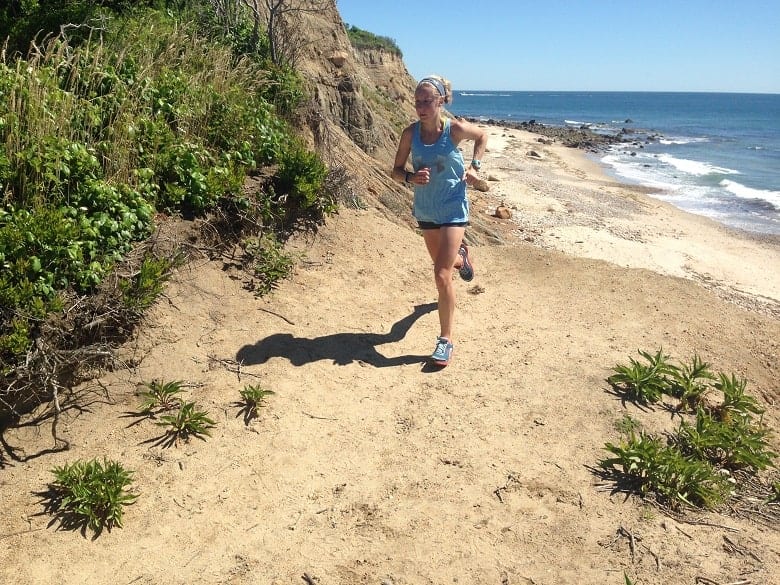
This can be uncomfortable for some and a major cause of gastrointestinal distress, and may also cause stomach pain when running or even a stomach ache after running.
Hence, you may feel not hungry after workout.
Also consider that our abdominal muscles also go through a lot with the up and down motion of running, including altered motility and endocrine secretions.
Here are some of the common nutrition reasons I see gastrointestinal distress in runners.
A. Dehydration
Now that we know blood flow is diverted from the gut during exercise, imagine having less blood flow overall.
Dehydration causes thicker blood, making it more difficult to flow. Dehydration can also affect performance, mental capacity and electrolyte balance.
Strenuous exercise and dehydration are the most common cause of gastrointestinal symptoms, according to a review published in the Current Opinion in Clinical Nutrition and Metabolic Care.

I love to make a homemade electrolyte drink after my long runs, but I also rely on UCAN.
My favorite electrolytes to help with dehydration are UCAN’s watermelon electrolytes. They quench thirst while also providing essential electrolytes.
Progressive dehydration further decreases blood flow to the gut, causing even more gastrointestinal distress.
The general rule of hydration is to avoid losing over 2% of your body weight during exercise.
Losing too much fluid can lead to a slower delivery of nutrients and oxygen to cells, altered body temperature and muscle cramping.

B. Improper Nutrient Timing
This is especially important for a beginner runners diet.
Stick to Simple Carbs
Before a run or workout, consider sticking to refined, fast-acting carbohydrates (white bread, white rice) that our muscles can use quickly. Not only will they be digested quickly, but they will also provide “quick energy” to use during the run.
Here’s a primer on what to eat before running in the morning and list of my favorite snacks for runners.
Pre workout vs post workout nutrition recommendations vary for a reason. Understanding healthy snacks for athletes and when to eat them is so important.
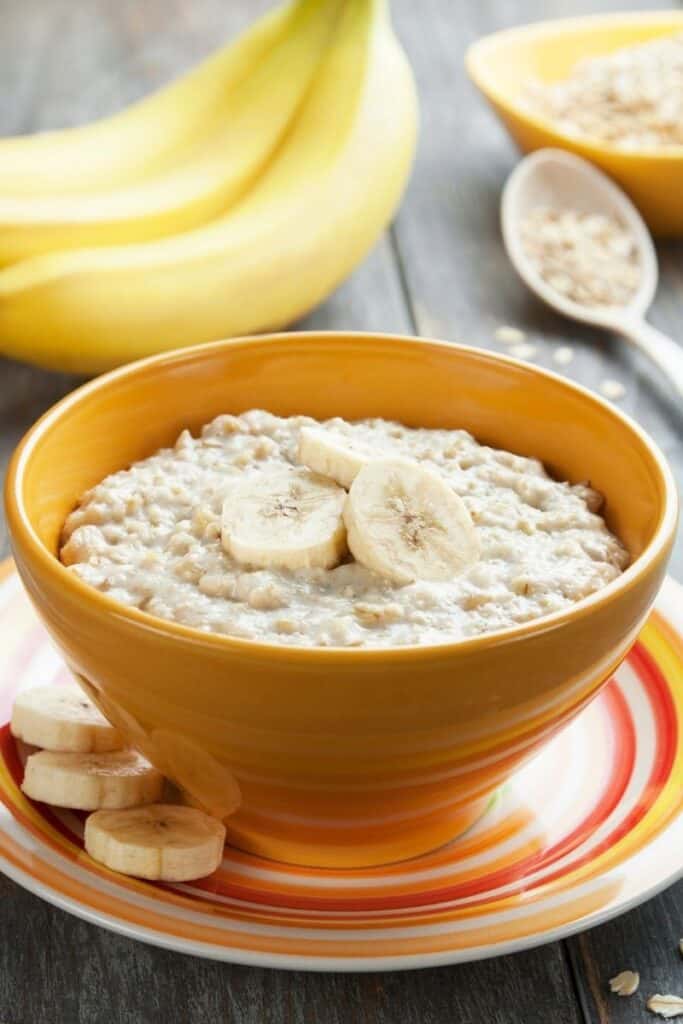
Make a Foods List or Sample Meal Plan
If you’re running longer, you still want to stick to easy-to-digest carbs, just in higher quantities. Here are some great tips on what to eat before a long run.
While I’m not a huge fan of meal plans, I will say in some situations they can help retrain you as to how much you need to eat and when to eat around exercise.
Marathon nutrition takes lots of practice!
For example, a sample meal plan for marathon training can help someone understand portion sizes, and when to aim to include more or less of a certain macro or micronutrient around a run.
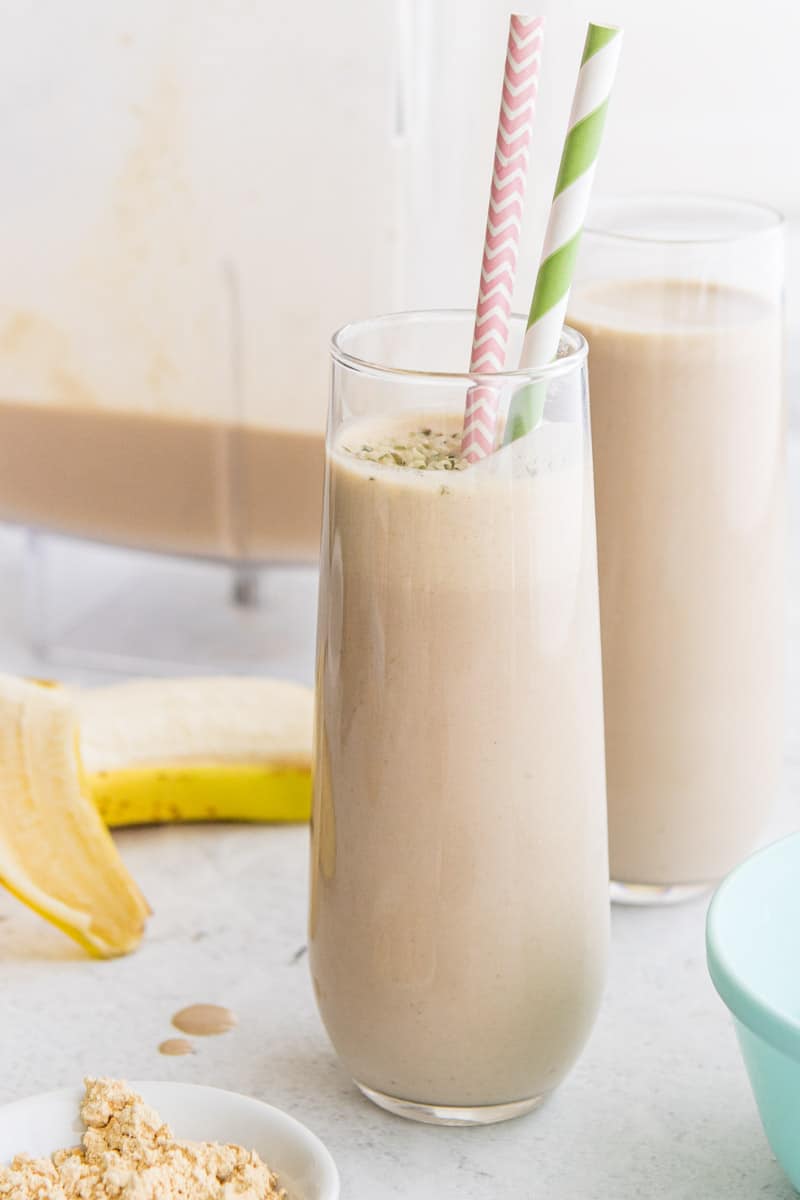
Allow Time to Digest
Aim to eat larger meals 2-3 hours before a run to allow time to digest. Many runners also see success in cutting out high-fiber foods days before a longer run or race.
If you can’t seem to figure out what foods are causing, keep a food journal and focus on reducing one high fiber food at a time before a run.
Caffeine can also cause discomfort for some runners – read more here about caffeine before running and the difference between coffee vs pre -workout before running!
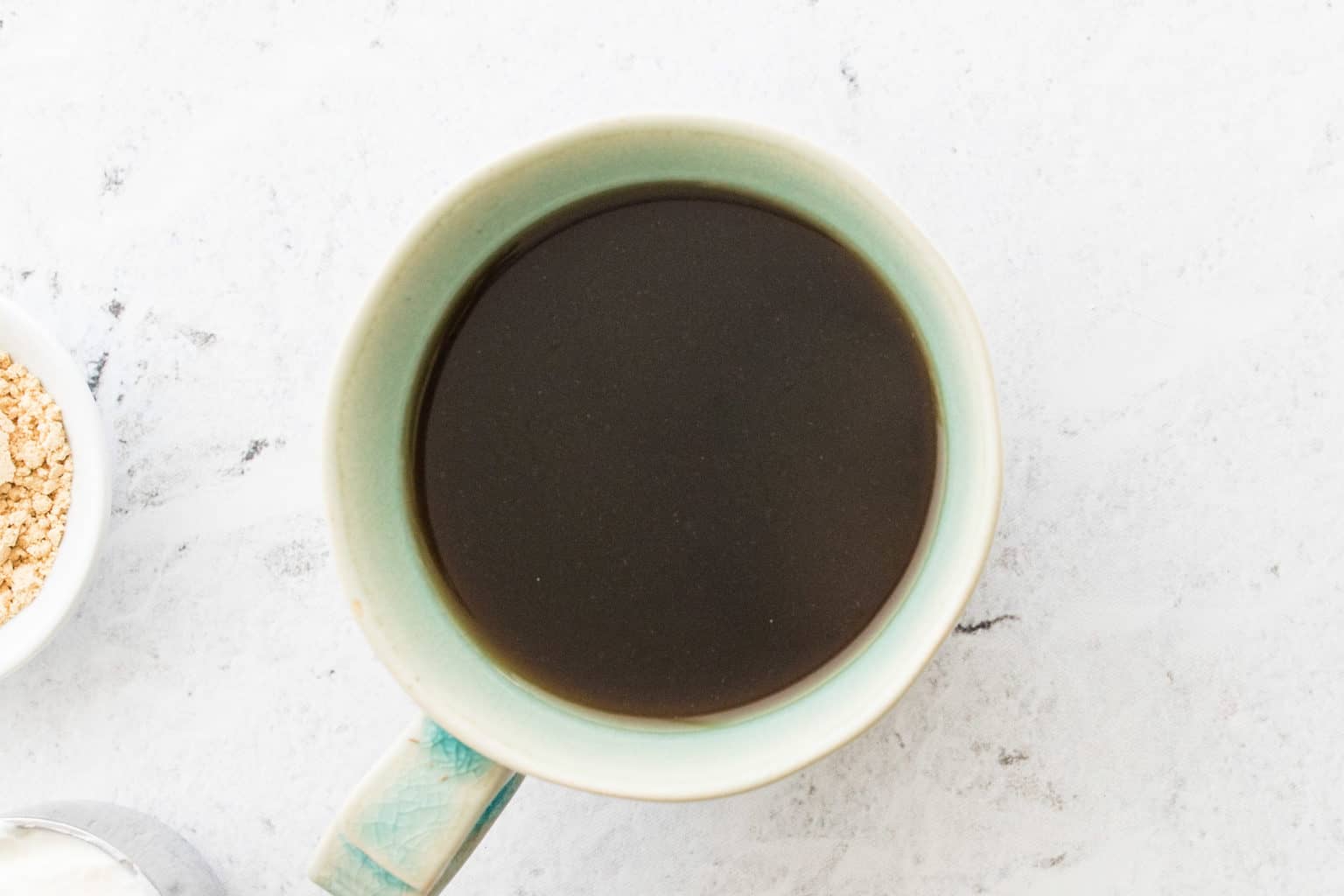
C. Improper Balance of Nutrients
If you suffer from runners stomach pain, this may be more pertinent to you.
Normally, we want to consume adequate fiber and healthy fats for our health and well-being. However, before exercise, they aren’t the best choice.
- Fiber is a non-digestible carbohydrate, meaning it passes through our GI system undigested. This can result in gas production and cramping. Foods like whole grains, nuts, beans and legumes, fruits and certain vegetables (like cruciferous vegetables) are very high in fiber.
- A vegan diet for runners is typically high in fiber, so may require some modification in and around runs, especially when carb loading for a marathon.
- Fat takes a long time for our bodies to break down and may lead to feelings of sluggishness and discomfort during exercise. Eat high-fat foods, like avocado, nuts, seeds, full-fat dairy, hours before exercise or save them for after running to avoid runners stomach symptoms.
Maple water is another great option that’s not too hyper-osmolar, easy on the stomach and can be hydrating!
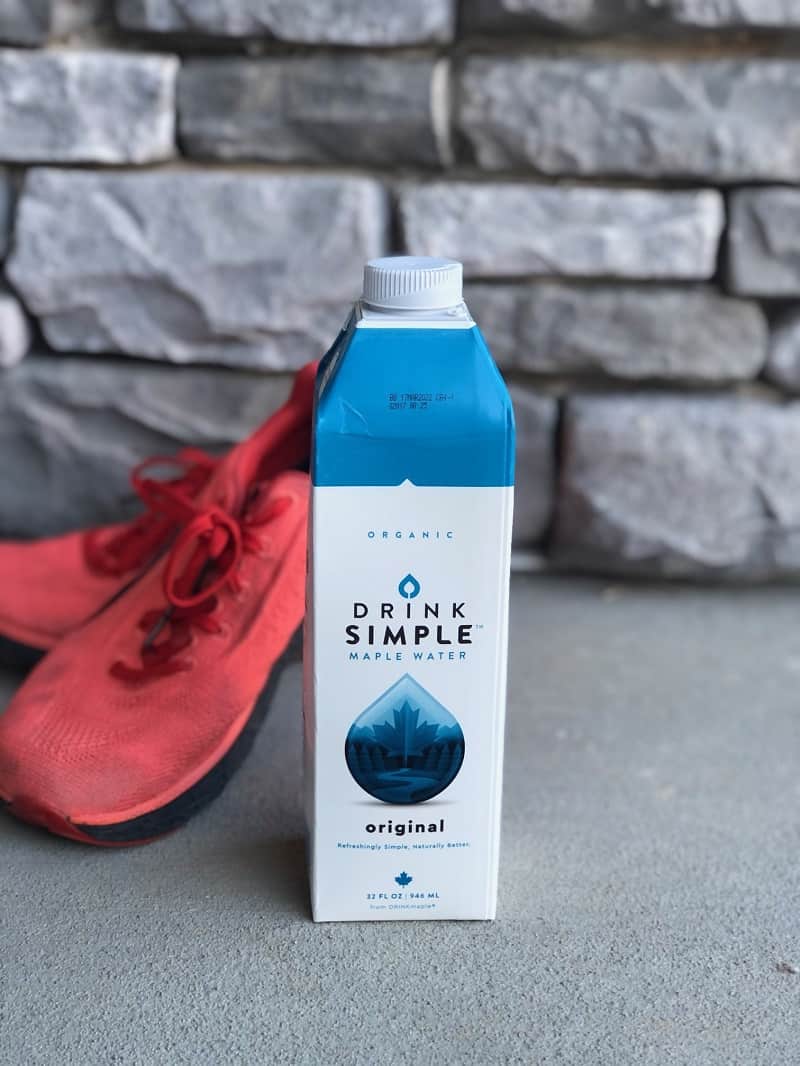
There are also some other theories for why some of us experience runners gut symptoms and altered GI symptoms during running, which include:
- mechanical forces of running –> agitation of the gut
- fluid shifts
- decreased splanchnic blood flow
- increased body temperature
- changes in bowel transit time
- hormone shifts
- autoimmune changes
How to Stop Runners Stomach
So, we’ve discussed what runners stomach is, and some of the things that exacerbate runners stomach pain.
Now, let’s specifically discuss how to stop runners stomach, so you can feel and perform better!
1. Make a Hydration Plan
Since hydration needs may vary by person, weather and environment, and how trained someone is, it’s difficult to give precise recommendations.
This post talks a little bit more about water needs during exercise and here’s a complete guide to hydration for running.
A good rule of thumb is to consume eight ounces of fluid 15-30 minutes before a run, and 16+ ounces a few hours prior.
During a long run, drink to prevent thirst, although sometimes it can help to drink according to time. A good starting point is 0.4 to 0.8 liters per hour.
Pro tip: always keep a handheld bottle with you!
After exercise, replenishing lost water is also crucial and it doesn’t have to just be through sports drinks. Chocolate milk can be a great way to rehydrate with electrolytes, too!
Other great hydration/electrolyte options include:
- Tailwind
- NUUN electrolyte tabs
- Skratch Hydration
- UCAN (Since this is sugar free, it settles well for many runners)
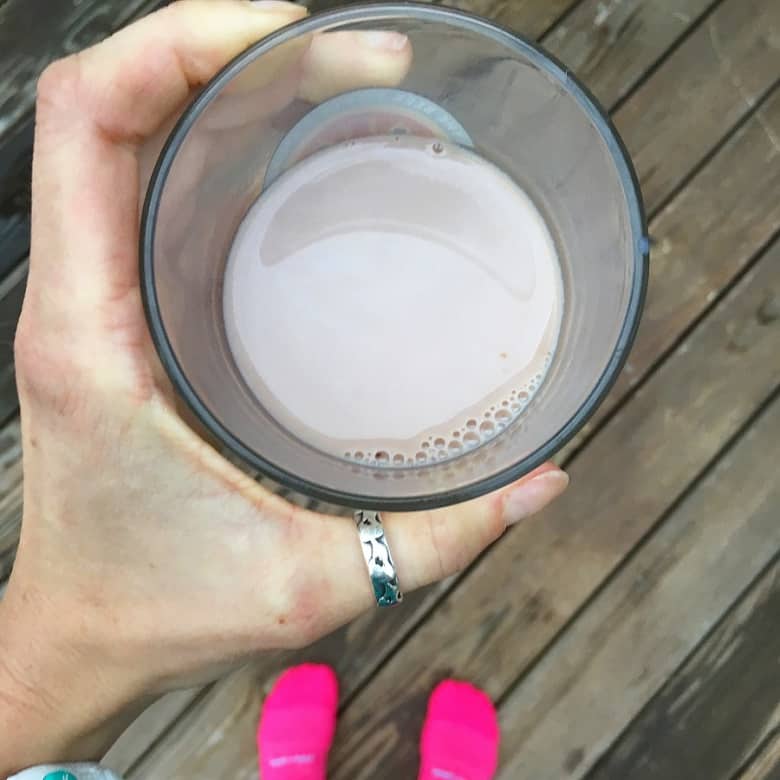
To make it simpler, to avoid dehydration, drink sufficient water before, during and after exercise.
Add in adequate electrolytes, particularly sodium, during longer runs to maintain fluid balance.
If you’re a salty sweater, you may want to consider having a sweat test done with a professional and adding salt tabs in either before or during a run.
A DIETITIAN IN YOUR POCKET?!
Are you always hungry?! This is the sports nutrition resource you’ve been missing in your training and every day life. Here’s you can make sure you’re eating enough for daily life, performance and recovery. – grab it now!
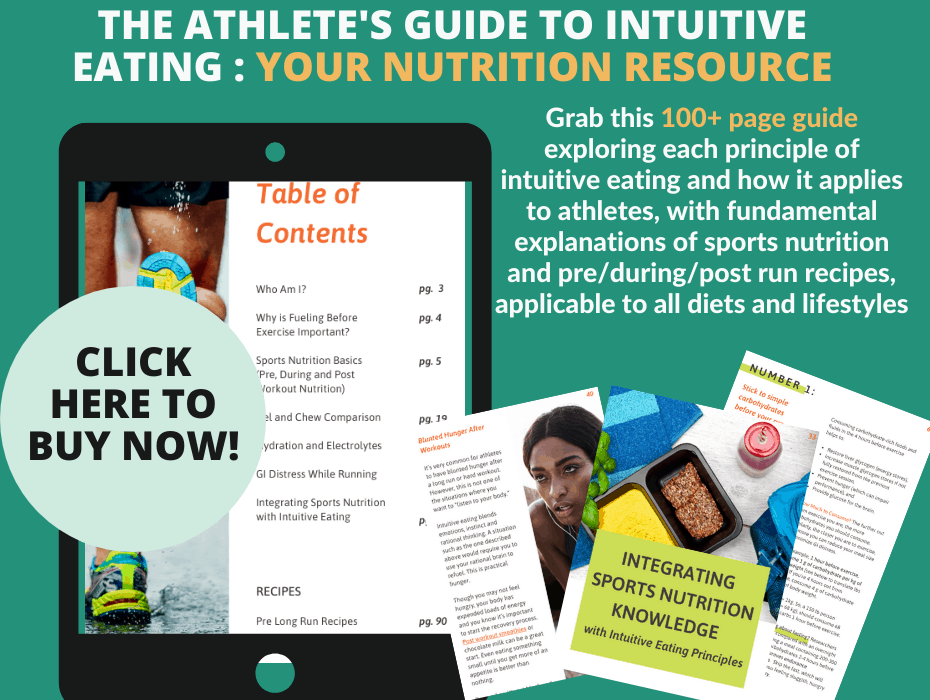
2. Time Your Nutrition
While it may not be possible to completely stop all runners stomach aches, I’d bet that this one is a big one.
Stick with easier-to-digest carbohydrates before exercise, like toast or a banana, so nothing is sitting in your stomach when you start your run.
Some people may want to go even more specific, and stick with simple carbohydrates (white toast) vs. complex carbohydrates (whole wheat toast) because they have less fiber and are likely to cause less discomfort.
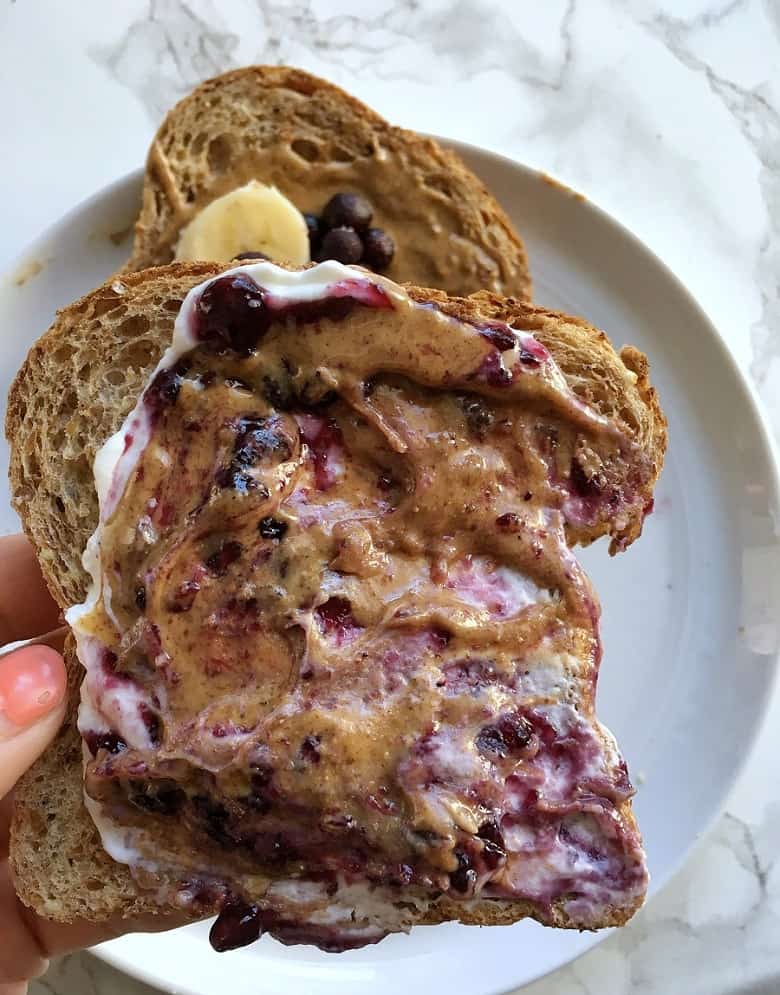
For exercises under an hour, it’s usually not necessary to add fuel in during your run.
However, when you are fueling during workouts, I always recommend practicing different products and keeping a food journal to record any adverse symptoms.
For example, you may feel better with an all-in-one powder mixed in with your water (like Tailwind or UCan), or you may prefer bloks, running chews or gels.
If you have a sensitive stomach, or feel that you are very sensitive to sugar content, Generation UCAN has a great product that utilizes superstarch (basically, a slow releasing carbohydrate) rather than quick acting sugars.
Or, just consider foods that are easier on the stomach, like boiled salted potatoes or homemade pomegranate tart cherry gummies.

Generally, protein and fat are unnecessary during exercise, but protein is important for recovery foods.
Most people do not spread protein throughout the day, which is one of the most important cardinal rules of protein for runners.
This is where something like a protein shake for runners could be very helpful.
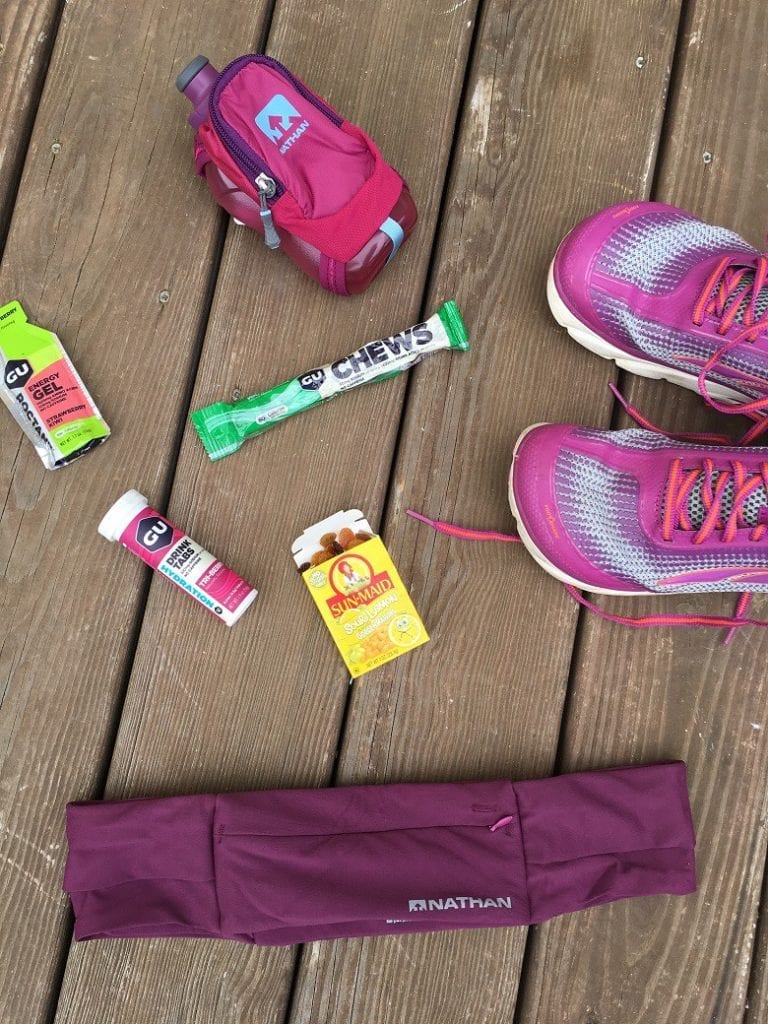
Additionally, adding recovery foods, like tart cherry juice, turmeric and antioxidant-heavy foods, may help too.
This sweetpotato smoothie is wonderful for replenishing muscle glycogen stores and adding antioxidants after a run.
3. Don’t Overdo Fat and Fiber Before Exercise
We discussed above why this is important. Fiber and fat are great for satiety, but not so great for fueling exercise.
Perhaps the night before a long run or race, you cut down on the fiber and fat. That doesn’t mean you have to eliminate vegetables and whole grains altogether, just the ones that cause the most symptoms.
Cooking vegetables (rather than eating them raw), can also make them easier to digest and prevent some gastrointestinal distress.
4. Consider Probiotic-Rich Foods and/or Supplements
Probiotics, also known as our live bacteria, may lower the incidence of GI symptoms apart from running, so it makes sense that they may also make your gut feel better during running.
Probiotics can reduce inflammation and improve the response to oxidative damage, a by-product of running. I love this site for finding a prebiotic or probiotic specially customized for your needs.
We do have some research demonstrating that they may improve endurance performance, as gastrointestinal health is important for regulating the adaptation to exercise.
In a 2011 double-blind, randomized controlled trial, competitive cyclists who supplemented with Lactobacillus (a popular probiotic) saw reduced severity in gastrointestinal symptoms, compared with those taking a placebo.
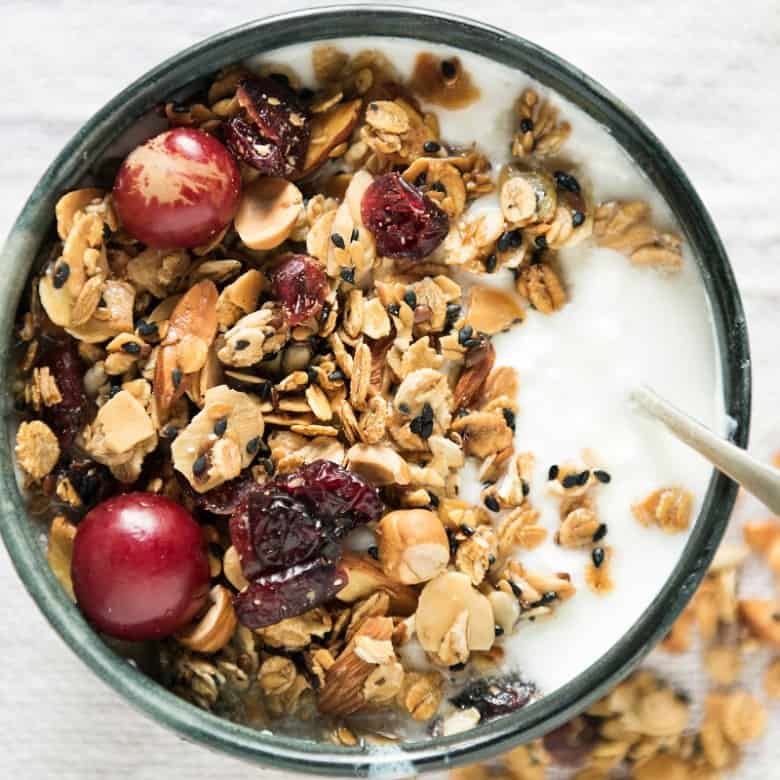
So, are probiotics the cure to your gastrointestinal distress and lower abdominal pain when running? Probably not, but they may be a piece of the puzzle!
There do seem to be modest benefits to including probiotics for performance, but more research needs to be done. It’s worth adding some probiotic-rich foods into your diet to see if that helps with digestion and GI symptoms.
Some of my favorites are:
- jerusalem arthichokes
- kimchi
- sauerkraut
- tempeh
- cultured dairy and non-dairy yogurts
5. Include Adequate Electrolytes and Energy Throughout the Run
In most instances of distance running, we do need and require fuel and carbohydrates during exercise.
Depletion of our carbohydrate and energy stores is associated with fatigue, reduced energy output (i.e performance decline), reduced skill and concentration and increased perception of effort.
This is why we recommend incorporating some tricks, like carb loading for runners, when preparing for a marathon.
I usually recommend my runners to start with 30-60 grams of carbohydrates per hour over 75 minutes. This could mean about 2-3 gels/hour, or half gel every 10 minutes, whatever works.
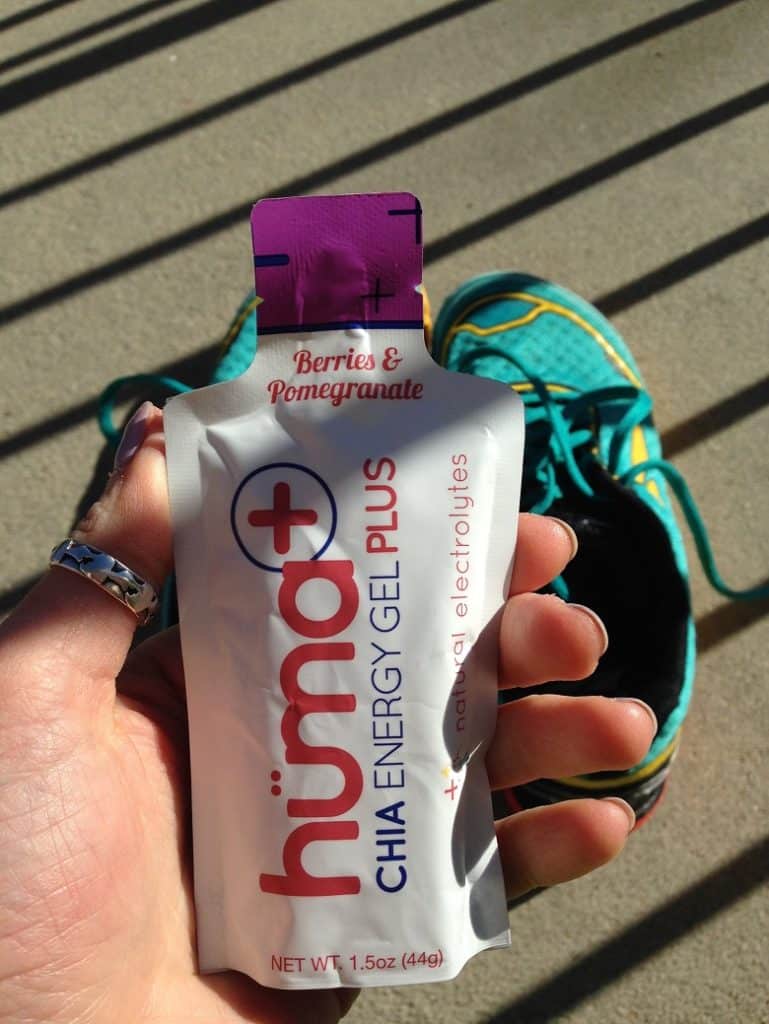
Taking gels at regular intervals can help your brain and body to receive a steady flow of glucose.
It’s also important to be eating enough IN GENERAL throughout the day. These recipes for marathon runners are a great place to start!
If you are someone who suffers from gastrointestinal distress during running, it may be prudent to start practicing fueling and drinking very early in the run.
Or, even practice fueling at regular intervals (i.e. – every 30 minutes) to see if it reduces symptoms or severity.
Key Takeaways
- Some of the major causes of runners stomach include eating the wrong foods, eating too close to running, being dehydrated, fluid and electrolyte loss, and hormones.
- GI disturbances can affect between 30-83% of runners, and as you may think, this can certainly hamper performance.
- Strenuous exercise and dehydration are the most common cause of gastrointestinal symptoms, according to a review published in the Current Opinion in Clinical Nutrition and Metabolic Care.
- Try to stay adequately hydrated and take in enough carbohydrates during long runs to reduce nausea.
- Probiotics may be a good tool to incorporate into your diet when not running, in addition to changing up the timing of your meals.
References:
- Simons, S., Shaskan, GG (2005). Gastrointestinal problems in distance running. International Sport Medicine Journal, 6(3), 162-170. https://www.researchgate.net/publication/298984198_Gastrointestinal_problems_in_distance_running
- de Oliveira, E. P., & Burini, R. C. (2009). The impact of physical exercise on the gastrointestinal tract. Current opinion in clinical nutrition and metabolic care, 12(5), 533–538. https://doi.org/10.1097/MCO.0b013e32832e6776
- West, N. P., Pyne, D. B., Cripps, A. W., Hopkins, W. G., Eskesen, D. C., Jairath, A., Christophersen, C. T., Conlon, M. A., & Fricker, P. A. (2011). Lactobacillus fermentum (PCC®) supplementation and gastrointestinal and respiratory-tract illness symptoms: a randomised control trial in athletes. Nutrition journal, 10, 30. https://doi.org/10.1186/1475-2891-10-30
- Thomas, D. T., Erdman, K. A., & Burke, L. M. (2016). Position of the Academy of Nutrition and Dietetics, Dietitians of Canada, and the American College of Sports Medicine: Nutrition and Athletic Performance. Journal of the Academy of Nutrition and Dietetics, 116(3), 501–528. https://doi.org/10.1016/j.jand.2015.12.006
Support Bucket List Tummy




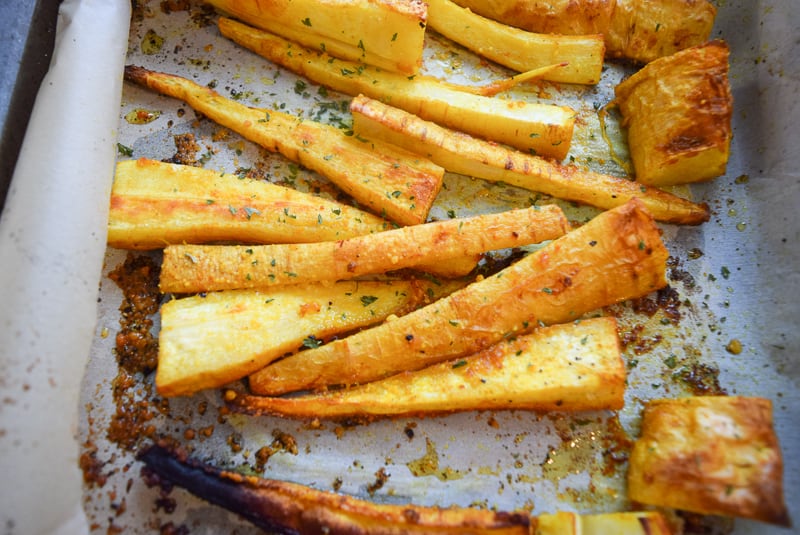
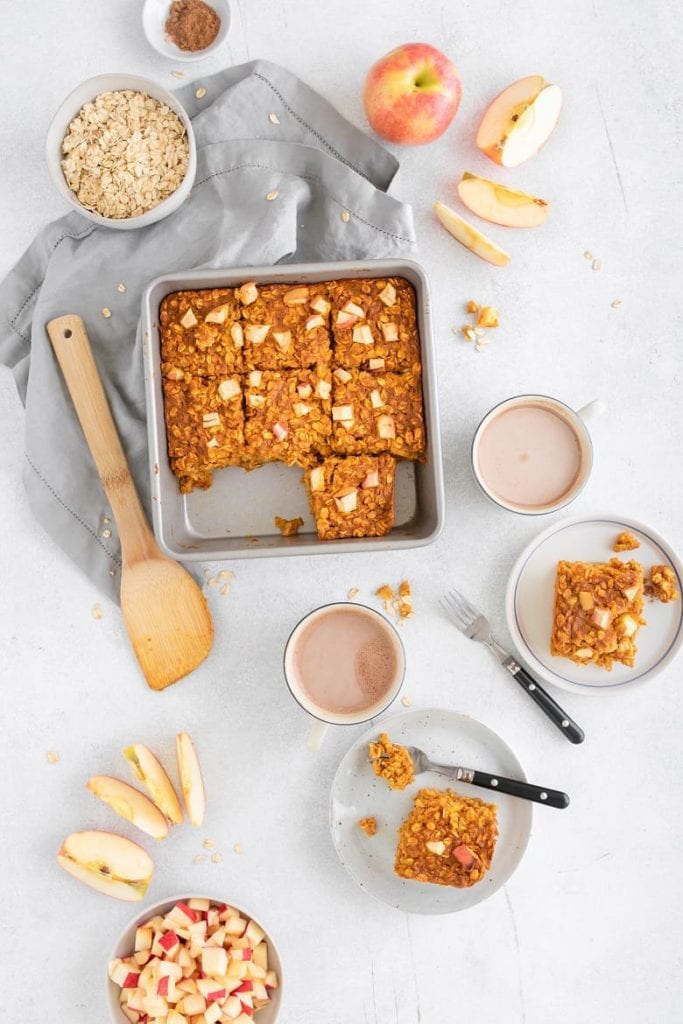


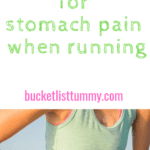
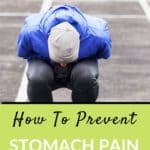
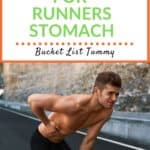
Like This Content?
Support Bucket List TummyHello,
Great article :). Today i run for 7km. I just started running. It was my third treadmill run. One hour after run i started to have lowe abdominal pain. Its like cramping. Pain goes away, but then it comes back ;(. It is like that for like more then 10 hours. My stool is normal, but it is more frequent. I play play soccer 3x a week and go to the gym, but maybe my body is not custom to this type of workout. Thank you once again for the artical. Greetings from Serbia 🙂
It’s amazing how nutrition can play such a big part in runner’s gut. Over the years, I’ve found that I really have to listen to my body about what it wants before/during/after a run.
Thank you so much for sharing all your amazing nutrition knowledge in these posts Sarah!
Great article, Sarah! Dehydration has been the main issue for me in training and racing, especially as I am usually nursing a baby while training. Hydrating a little extra during the entire race week has helped me immensely. It took me one majorly dehydrated race to figure that one out – that race was miserable!
very informative! I’m definitely going to share this as I think there are still a lot of people out there who don’t quite know how to get it right!
Thank you, I appreciate the share!
Great info! When I first started running I felt like I had a pretty solid stomach but in recent years it’s become pretty temperamental. I’ve been using Tailwind and that seems to be sitting well with me.
I love Tailwind as well. Glad you’ve found something thats working!
I feel pretty lucky that I don’t have stomach issues on runs. Every once in a while something will feel off but I’m glad it’s not a constant issue. It could definitely be because I know what works and never stray from it haha.
Chocolate milk post run is the best! Love that it’s actually good for you post run since it’s chocolate haha.
If you know what works for you, that’s great – stick to it!
This is great info! In recent years, I have had issues with gels (during long runs or half/full marathons). I have found that I have to make sure to keep the plain water flowing and not over-do the Gatorade while on the race course. The Honey Stinger gels work better for me than GU, but the HS chews seem to be my best option currently.
I’m glad you’ve found what works for you, Kimberly!
I feel like I’ve gotten a handle on my runner’s tummy…until I haven’t. Today, I had issues while running on the treadmill. Thankfully, I could take breaks as I needed. You’ve got great tips here.
The treadmill is great for that, and for testing new fueling regimens. I hope it works itself out!